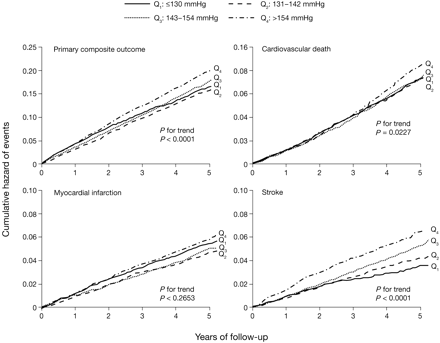-
PDF
- Split View
-
Views
-
Cite
Cite
Peter Sleight, Further evidence from ONTARGET: additional vascular protection, European Heart Journal Supplements, Volume 11, Issue suppl_F, December 2009, Pages F16–F18, https://doi.org/10.1093/eurheartj/sup031
Close - Share Icon Share
Abstract
ONTARGET showed equivalent cardiovascular outcomes from further blood pressure lowering (from near normal) by ramipril, telmisartan, or their combination in over 25 000 well treated high risk randomized subjects. Data from all subjects were pooled to examine the relation between baseline, or achieved BP and several outcomes. There was a linear relation for stroke down to in-treatment systolic BP of about 120 mmHg. Cardiovascular death, or myocardial infarction, showed a J-curve, with nadir around 130 mmHg, particularly in those with baseline systolic BP <130 mmHg. These observations question the recommended advice to lower systolic BP more aggressively in higher risk subjects.
The recently published ONgoing Telmisartan Alone and in combination with Ramipril Global Endpoint Trial (ONTARGET) was conducted in a large sample of older, treated patients (more than 25 000, normalized or mildly hypertensive) with high risk of cardiovascular disease or with complicated diabetes who were tolerant to angiotensin-converting enzyme (ACE) inhibitors. In ONTARGET, the incidence of the primary composite outcome of death from cardiovascular causes, myocardial infarction (MI), stroke, or hospitalization for heart failure were similar for the angiotensin II receptor blocker telmisartan (80 mg), the ACE inhibitor ramipril (10 mg), or their combination. In addition to trial medication, the subjects in ONTARGET were well treated with other antihypertensives (beta-blockers, 57%; diuretics, 28%; calcium-channel blockers, 33%) and other drugs to reduce cardiovascular risk (statins, 60%; antiplatelet therapy, 80%).
In a recent analysis,1 subjects in all three treatment groups in ONTARGET (n = 25 588; mean age = 66 years) were pooled to analyse the impact of blood pressure on cardiovascular events. The primary composite outcome and its components were related to baseline systolic blood pressure (SBP; divided into quartiles), to the magnitude of SBP changes from baseline to event (divided into tertiles), and to average in-trial SBP (divided into deciles), using a multivariate Cox proportional hazard model both unadjusted and adjusted by age, gender, and several covariates including as diabetes, ethnicity, cardiovascular disease history, and concomitant therapy.
The risk of stroke increased significantly and progressively with increasing baseline SBP (P < 0.0001) and decreased with in-trial SBP reduction (Figure 1). Cardiovascular mortality was only significantly related to baseline SBP in those with baseline SBP >154 mmHg (P = 0.0227 for increase in risk). The risk of MI was not significantly related to baseline SBP.

Kaplan–Meier curves relating baseline systolic blood pressure to the unadjusted cumulative hazard of the primary outcome (cardiovascular mortality, myocardial infarction and stroke) in ONTARGET. Reproduced with permission from Sleight et al.1
In subjects with baseline SBP above the median (142 mmHg), greater reductions in SBP resulted in a significantly reduced risk of the primary composite endpoint and of stroke; the risk of MI was unaffected by further SBP reductions. The benefit on the primary composite endpoint from SBP lowering <130 mmHg was driven mostly by a reduction in stroke. Adjustment for several covariates lessened the apparent benefit on both the primary composite endpoint and stroke of further blood pressure reduction in subjects with baseline SBP <142 mmHg. In subjects with baseline SBP <130 mmHg, again adjusted for several covariates, cardiovascular mortality significantly increased with further SBP reduction (P < 0.0001).
A ‘J-curve’ occurred in the relation between in-treatment SBP and the risk of cardiovascular mortality (nadir 130 mmHg) or MI (nadir 126 mmHg); no J-curve occurred for stroke (Figure 2). These findings emphasize that lowering blood pressure beyond a certain critical level in subjects with advanced cardiovascular disease or high-risk diabetes, such as those enrolled in ONTARGET, may increase their cardiovascular risk.

Adjusted risk of outcome events by achieved systolic blood pressure, divided in to deciles (grey bars). The shallow nadir of the J-curve is spread over several deciles and occurred around 130 mmHg SBP for all outcomes except stroke. The reference value for the hazard ratio applies to SBP 121 mmHg. Reproduced with permission from Sleight et al.1
In conclusion, hypertension guidelines advise aggressive blood pressure lowering in subjects with diabetes or atherosclerotic disease. However, our observations question the uncritical application of lowering SBP more aggressively in older higher risk subjects; in particular, the value of SBP lowering in those with SBP in the range of 130–150 mmHg.



